This post is comprised of different sections
Take a look at our review of Raphaelesque Head Exploding!
Learn more about the WWII atomic bombings!
This post is comprised of different sections
Take a look at our review of Raphaelesque Head Exploding!
Learn more about the WWII atomic bombings!
Artist: Salvador Dalí
Year: 1951
Medium: Oil on wood
Location: Scottish National Gallery of Modern Art, Edinburgh, UK
Dimensions: 43.2 x 33.1 cm
Original Title: Tête Raphaèlesque éclatée

Our rating
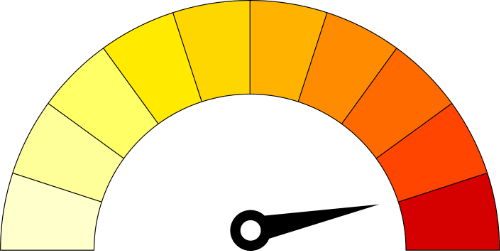
Your rating
When I was starting out my career, I came across the book Functional Magnetic Resonance Imaging by Scott Huettel and collaborators.
And there was something that immediately caught my attention:
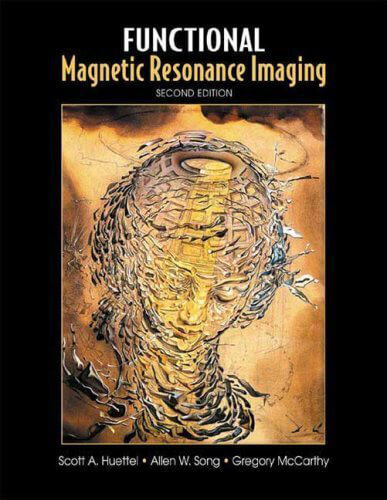
This cover had always intrigued me. Whose head is this supposed to be? Why does it look fragmented? Does the hole have sexual connotations, like some of Dalí’s other paintings? Why have the authors/publisher chosen this particular image?
Being a neuroscience book covering multiple fields (from physics to the analysis of human fMRI studies), I thought the authors/publisher may have used it given Dalí’s interest in the mind, particularly the subconscious mind.
I did little at the time to search for an actual interpretation of this painting, but I surely felt immediately drawn to it. Still to this day, Raphaelesque Head Exploding remains one of my favourite surrealistic works… ever!
Sadly (or maybe not), from the 3rd edition of the book the publisher changed the cover to another of Dalí’s works: Maximum Speed of Raphael’s Madonna, a painting completed 3 years after Raphaelesque Head Exploding.
Recently I was perusing my library and came across that old companion book, reviving my interest in this painting.
So, let’s learn what it is all about!
Setting aside the grotesque title, Raphaelesque Head Exploding is a masterpiece to behold.
The entire head is made up of what looks like fragments of unspecifying objects. A ray of light shines through a hole at the top of the head, the interior of which appears to be the cupola’s interior of the Pantheon of Rome.
Despite the fact that the face is barely visible, one cannot but notice a certain beauty of the facial features: an almost motherly and affectionate pose, gentle lips and a hint of a smile.
Like some of Dalí’s other works (e.g., The Anthropomorphic Cabinet), Raphaelesque Head Exploding is parsimonious in its use of colour. A markedly warm and earthy golden ochre permeates the entire canvas, as though we were looking at an ancient papyrus.
Still, the painting has an incredible dynamism. Not only does the disposition of the fragments give the impression of floating around the face, but also the light beam appears to be penetrating the head from the opening at the top.
A wheelbarrow is shown at the bottom left of the painting, a curious addition given the otherwise sober and controversial theme of the painting, the cataclysmic destruction by nuclear weapons.
The woman’s face is most likely a representation of the Madonna as envisioned by Raphael, hence the title.
Dalí is one of my favourite surrealistic painters, and Raphaelesque Head Exploding probably my favourite work of his. The intricately detailed painting, the illusion of gracefulness and the softness of the face, despite being made up of chaotic fragments, is nothing short of brilliance.
As we will see below, Dalí played with contrasts, and the effect was simply astonishing. Joy and sadness, pleasant and unpleasant, safe and dangerous are feelings that, to a certain extent, are all expressed in this unique work of art.
Dalí’s fondness for science and the thematic controversy of the painting also surely contributes to giving the painting that extra appeal.
Raphaelesque Head Exploding gets a well-deserved star rating of 5.
Like most of Dalí’s works, Raphaelesque Head Exploding is, indeed, very bizarre.
However, despite this agglomeration of surreal elements, Dalí did provide clues as to what these different elements represent.
For this reason, art pundits have been able to, more or less, piece together the meaning of the painting.
In any case, given the very surreal appearance of the painting this work gets a bizarrometer score of 4.5.
As the name implies, Raphaelesque Head Exploding depicts an explosion of a head based on Raphael’s artistic vision.
Why the gruesome title?
Well, Dalí was living in the US when he learnt about the devastating effects of the atomic bombings of Hiroshima and Nagasaki. It awakened in him not only a certain apprehension regarding human’s potential for destruction, but also a certain obsession with scientific progress.
Hoping to fulfil his vision to reconcile science and religion, he coined the term “Nuclear Mysticism” to refer to works that drew on both religious and scientific views. Raphaelesque Head Exploding is one of such works.
The face is made up of fragments which are likely a representation of the debris created by the nuclear blast of an atomic explosion, and/or a vortex of sub-atomic particles which make up all matter. The suggestion of a halo and clouds above the head visually symbolise the atomic explosion.
The central subject of the painting resembles the face of Raphael’s Madonna (hence the title). The serene and motherly facial expression contrasts heavily with the destructive and lethal consequences of nuclear weapons as represented by the fragments, halo and mushroom cloud.
The interior of the head is covered by coffered panels resembling those on the ceiling of the Pantheon of Rome, a site of worship and connection to God (or gods). With this detail, Dalí may be implying a god-like faculty of harnessing the power of the atom.
Finally, the oculus, the small opening on the top of the head (which is also a defining feature of the pantheon) lets light into the interior of the head, symbolically, relating to the very bright light emitted shortly after a nuclear explosion.
As usual, before we delve into a more detailed interpretation of this painting, let’s go over a few facts that led to the atomic bombings on Japan during WWII, as well as an overview of the nuclear physics that made the construction of those bombs possible.
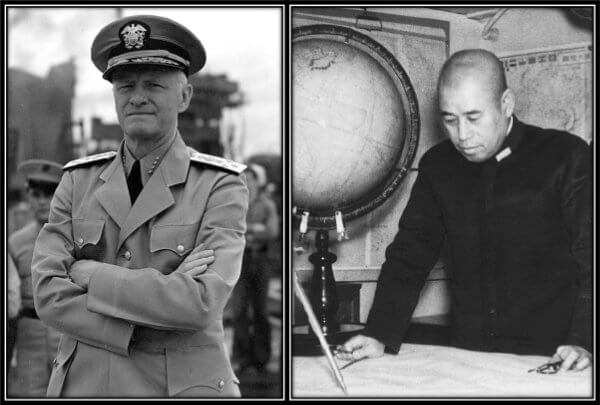
Japan entered the Second World War with the objective to occupy the Western colonies of Great Britain, France, the Netherlands and the US, all situated in South east Asia. Not only was this a move to expand its empire, but also to cease key natural resources (e.g., oil, coal) that Japan desperately needed if it were to become a great world power.
In 1931, Japan invaded Manchuria, a place rich in coal and iron. The US became unease, since they suspected Japan would take advantage of the war in Europe to capture the colonies of defeated European countries.
So, US president Franklin Roosevelt decides to send his Pacific naval fleet to Pearl Harbor, Hawaii, to be stationed there for training… and keep an eye on the Japanese.
Meanwhile, Japan makes a pact with Nazi Germany and Fascist Italy, boosting Japan’s intentions to continue their territorial expansion. As Roosevelt had predicted, after the fall of France to the Nazis, Japan invades French Indochina.
As retaliation, the US suspends all exports to Japan, effectively blocking Japan’s ability to purchase oil (which had mostly come from the US). Having thousands of troops stationed in China and other occupied territories, Japan desperately needed oil to sustain the presence of those troops.
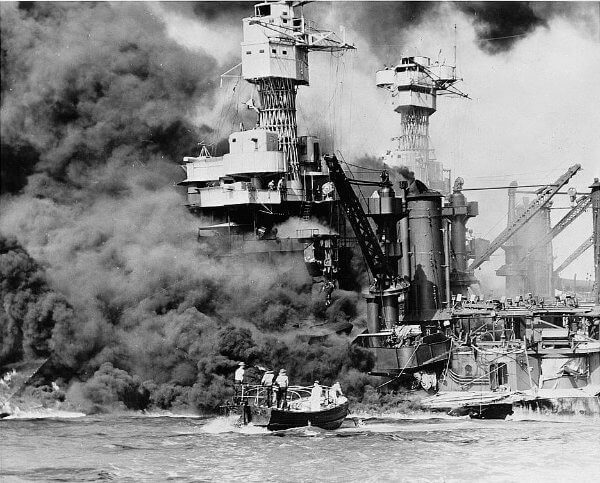
Based on the belief that the Americans would not be willing to get dragged into a lengthy war in the pacific, the Japanese military gambled that if they could destroy the US pacific fleet (now conveniently stationed in Pearl Harbor), the US would soon ask for peace, clearing the way for Japan’s expansion ambitions in the Pacific.
Japan’s surprise attack on the US naval base at Pearl Harbor, Hawaii on the 7th December 1941, sent a shockwave through the US.
Having been reluctant to enter the war prior to the Pearl Harbor attack, there was no question now. On the next day, the US declared war on Japan and officially entered WWII.
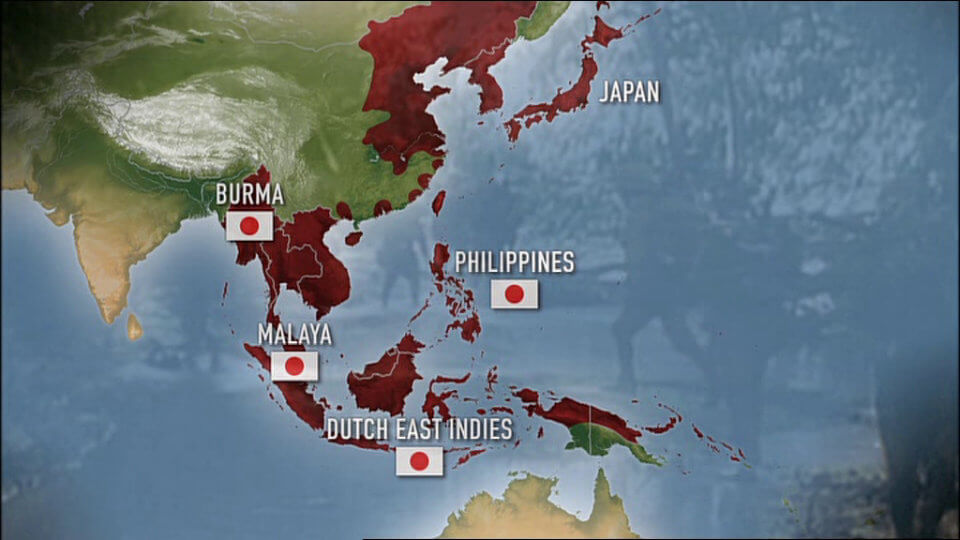
Believing to have crippled the US, Japan continued their expansion in South Asia.
In just under 6 months they had invaded and conquered Hong Kong, Burma, Thailand, Malaya, Singapore, the Philippines, the Dutch east Indies, the Solomon islands and other smaller pacific islands.
However, during those Japanese campaigns in South Asia, American codebreakers in Hawaii managed to crack Japanese encoded Japanese radio messages, giving the US an opportunity to anticipate Japanese attacks and catch them off-guard.
That was what happened in the decisive naval battle of Midway, in which the US came out victorious, effectively putting an end to Japan’s blitzkrieg in the Pacific.
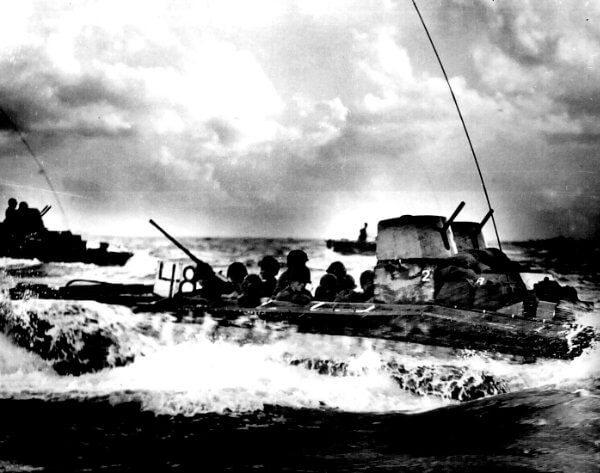
The tide now began to turn in favour of the Americans. Having defeated the Japanese in decisive battles both at sea and on land, and growing in strength by the day (thanks, in large part, to the American war effort), the US now focused on ceasing Japan’s occupied territories in order to cut their important supply lines of rubber and oil.
Around mid-1944, the US military successful launched a series of amphibious attacks on key strategic islands, such as the Solomon and Mariana islands. But these two important victories for the Allies came at a cost. More than ten-thousand American troops, many more Japanese troops, and thousands of civilians lost their lives.
The US then turned to the Philippines where they faced the terrifying Kamikazes (Japanese suicide units; see video above). After several months of fierce fighting, the US managed to retake the entire of the Philippines, but not without the loss of hundreds of thousands of combined American and Japanese troops and civilians.
In the early months of 1945, Japan was in a dire situation. Having been defeated at both sea and air, and suffering major territorial losses, the main Japanese islands were now dangerously cut off from vital supplies.
The Japanese, however, refused to admit defeat. Any attack to the Japanese islands was met with extreme brutality. In fact, Japan was convinced that if they continued fighting even more aggressively, the Americans would eventually concede, not being able to stomach it.
The US faced a major problem: how could they possibly defeat Japan once and for all without the continuing loss of American lives?
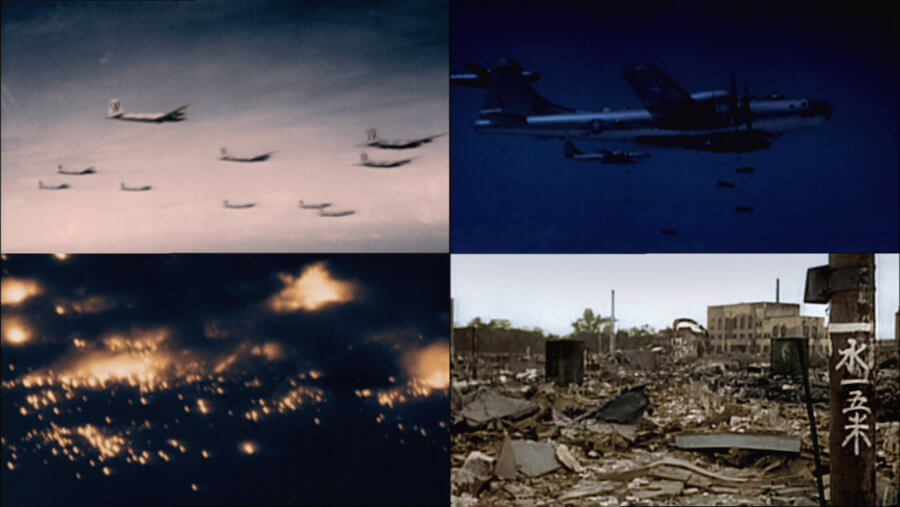
Initially, the US military employed strategic bombing raids, targeting Japan’s infrastructure and industrial areas. Despite some successes, accurate bombing was often thwarted by poor visibility and wind conditions. The American planes were also flying without a fighter escort and so were often easy targets for Kamikaze pilots.
The US then decided to employ a new bombing technique: incendiary bombing. Tokyo, Nagoya, Osaka and Kobe were among the targets of this firebombing, destroying much of the industrial facilities, and killed hundreds of thousands of Japanese citizens with many more made homeless.
In February 1945, the US invaded the island of Iwo Jima, which saw the deaths of about 7000 Americans and 18.000 Japanese. The Okinawa campaign a few months later was even bloodier, with a death toll of almost 100.000 Japanese soldiers, 15.000 American soldiers and about 40.000 civilians.
Even in the face of this calamity, the Japanese did not show any signs of wanting to surrender. The US pondered a full-scale invasion of the main island, but were concerned about the amount of casualties of such an invasion. The main Japanese island was defended by about one million men, supported by a few thousand airplanes. New Kamikaze pilots and even civilian volunteers were trained everyday to perform suicidal attacks on the potential invaders. With this intel, the US estimated that more than 200.000 American lives would likely be lost…
The US administration urgently needed a solution, and it would be a scientific breakthrough which would give them the trump card.
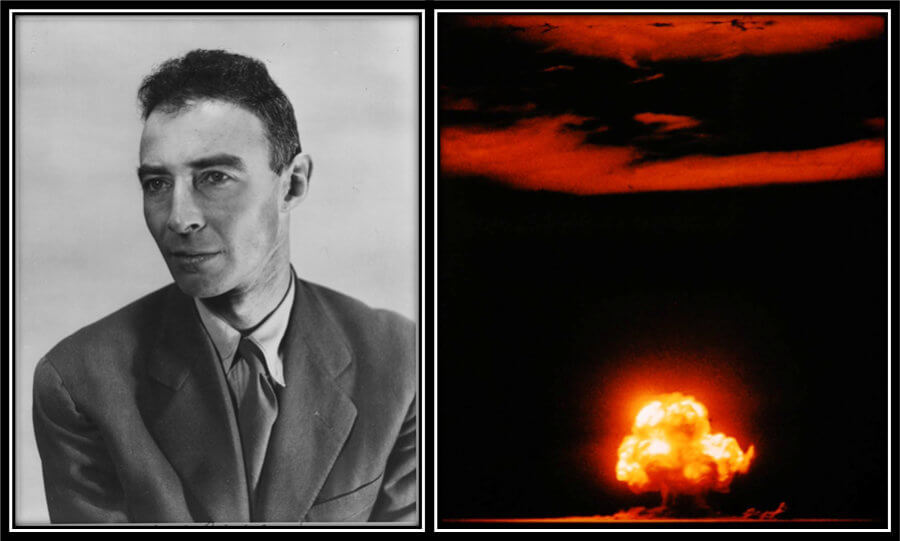
News of a classified scientific research project codenamed Manhattan Project reached the ears of US President Harry S. Truman.
While Truman was meeting Churchill and Stalin in Potsdam, Germany, he was informed of the success of Operation Trinity involving nuclear bombs, and ordered the manufacturing and dropping of the bombs on Japan immediately.
Two bombs were manufactured for that purpose: Little Boy and Fatman.
To understand the power unleashed by these bombs, let’s briefly go over some (very) fundamental chemistry and physics.
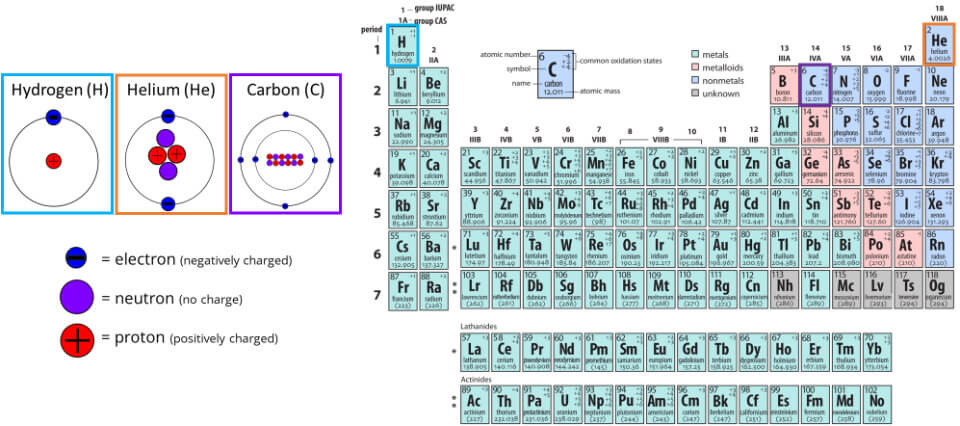
The way we tell different elements apart is by the number of protons in their atomic nucleus (i.e., their atomic number). So, hydrogen has 1 proton, helium 2 protons, carbon 6 protons, uranium 92 protons. You can see the atomic number of each element at the top left in the periodic table in the figure above.
Protons are positively charged and you might remember from your high-school physics class the old good force of attraction: like charges repel, unlike charges attract. The protons are tightly packed inside the nucleus of the atoms, so what prevents the protons from ejecting the nucleus?
The neutrons!
Just as protons, neutrons are also subatomic particles which, as the name implies, are electrically neutral. They can counteract the repulsive force of the protons and, thus, stabilise the nucleus. So, helium has 2 protons as well as 2 neutrons, carbon has 6 protons and 6 neutrons, etc.
As the number of protons starts to increase however, the repulsion between the protons will increase drastically. Take uranium for example. It has 92 protons, resulting in a massive repulsion. Adding only 92 neutrons would not keep these protons packed together; the nucleus would destabilise quickly and decompose into different, smaller and more stable atoms.
This process of disintegration from a bigger atom into smaller ones is called fission (the word “fission” comes from the Latin word fissiō, which means to break up or to divide), and the elements that result from fission are called the fission products.
So, the only way to make the nucleus of an uranium atom (U) stable is by adding a few more neutrons. Atoms with the same number of protons but with different amount of neutrons are called isotopes. Naturally occurring isotopes of uranium are U-238 (146 neutrons), U-235 (143 neutrons) and U-234 (142 neutrons).

Shortly before WWII, scientists had discovered that it would be possible to force U-235 to fission by shooting a neutron into the nucleus.
They noticed that if a neutron is bombarded very quickly into the nucleus of a U-235 a series of processes happen:
1) The nucleus absorbs the neutron and turns into U-236 (because it gained one additional neutron it’s atomic mass is now 236).
2) The addition of a neutron completely destabilises the nucleus of the atom
3) This destabilization causes the atom to split into two smaller and more stable isotopic elements, e.g., barium-139 and krypton-94.
4) In the example above, Barium-144 has 88 neutrons, whereas krypton-94 has 54 neutrons. The U-236 had 144 neutrons, but 88 + 54 = 142. This means that in addition to those smaller elements, there are two (or sometimes three, depending on the elements produced) additional neutrons released.
5) The free-floating neutrons have the require speed to collide with other U-235 atoms and cause new fissions. This generates what is called a chain-reaction.
One of the biggest hurdles the Manhattan Project scientists faced was the presence of meagre amounts of U-235 (about 0.7%) in natural uranium.
And low amounts of U-235 meant that the free neutrons would be absorbed at a faster rate than they were created, and the chain-reaction would not be self-sustaining.
So, they had to enrich uranium sufficiently until it reaches a supercritical mass, that is, the amount of U-235 required to trigger a chain-reaction.
And it is this chain-reaction of U-235 what makes a bomb go… BOOM!!!
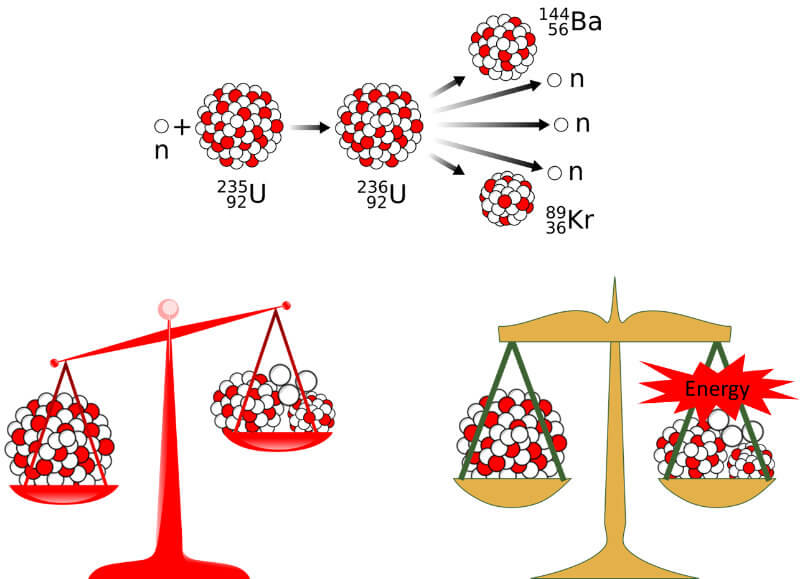
Now, this is important. Before fission, the atomic mass of the original U-236 is actually greater than the sum of the atomic masses of the fission products (see figure above). So where did the remaining mass go?
The answer: it has been converted into energy!
Remember, the only reason those protons and neurons are packed inside the nucleus is because there is a very strong force acting on them, the aptly named “strong force”. Thus, in order to break up a nucleus into smaller constituents you need energy – the binding energy. And larger nucleus have a higher binding energy. Once you are able to break the nucleus, this energy is also released.
So, in the example above, when fission splits the U-236 into the elements of Ba-144 and Kr-90 plus 2 neutrons, it also releases around 200 MeV (or 200 million electron volts). This amounts to about 3.2 x 10-11 Joules.
It doesn’t sound impressive, does it? After all, 3.2 x 10-11 Joules are a measly 0.0000000000032 Joules.
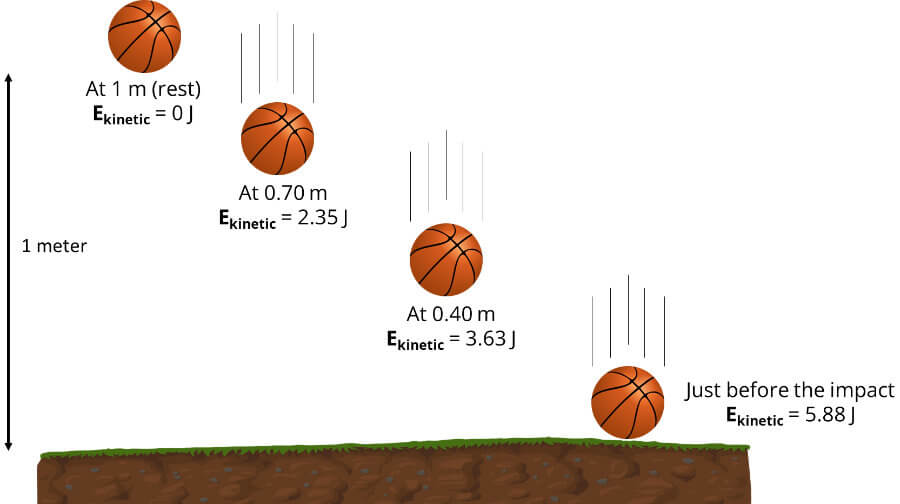
For comparison, if you drop a basketball from a height of 1 meter, the ball will have gained about 5.88 Joules just before it reaches the ground (see figure above) – that’s more than one hundred billion times larger than the energy released by the fission of a single atom of U-235. And if you explode one ton of TNT, it will release an astonishing 4184000000 (or 4.18 x 109) Joules worth of energy.
However, you need to realise that when the atomic bomb was dropped in Hiroshima, about 0.90 kg of uranium underwent fission in a matter of picoseconds. And 0.90 kg contains about 2.30 x 1024 of U-235 atoms! Simple math will tell us that if 2.56 x 1024 atoms of U-235 do fission, it will lead to the release of 4.61×1026 MeV or about 7.4 x 1013 Joules!
And that’s a massive amount of energy!!!
And, you see, there was about 64 kg of uranium in Little Boy, however only less than 2% actually became fissile! The rest was dud uranium.
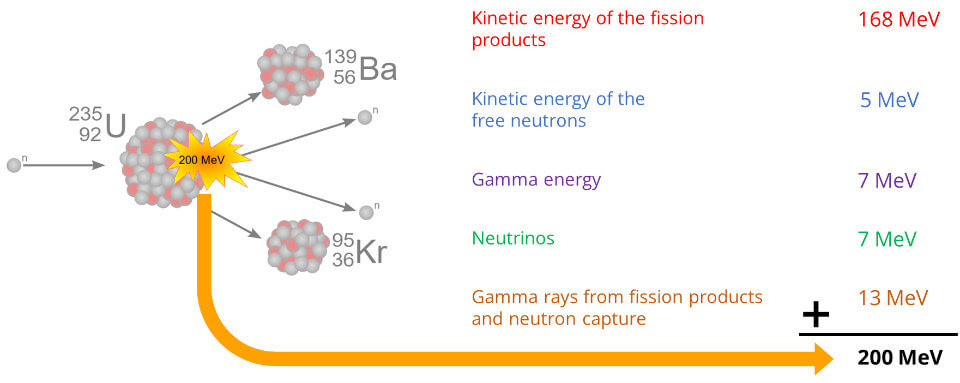
As explained above, when an atom of U-235 undergoes fission, it releases about 200 MeV of energy.
Out of these 200 MeV, the most part – about 169 MeV – is kinetic energy of the fission products. Other fission fragments that contain kinetic energy include free neutrons (about 5 MeV), gamma ray photons (about 7 MeV) and neutrinos (about 7 MeV).
What exactly comprises the 169 MeV of energy? Due to their nuclear charges, the two fission products will experience a very large repulsion and will tend to move away from each other. Thus, they will have kinetic energy.
Kinetic energy is the energy of motion. To put simply, if an object is moving, it will have kinetic energy (think of the basketball example I mentioned above), and the faster it moves, the higher it’s kinetic energy will be. A basketball will hurt your face more if it hits you at a faster speed, since there will be more kinetic energy that can be transferred to your face.
About 7 MeV are energy from immediate gamma rays. These are extremely energetic photons (light particles), and there will be so many released from a nuclear explosion that a very bright light will be seen even before any sound is heard (see below).
The remaining energy comes from gamma rays from fission products and neutron capture (total of about 13 MeV).
If you add all these up, you will come to approximately 200 MeV – the total energy released by the fission of a single U-235 atom (see figure above).
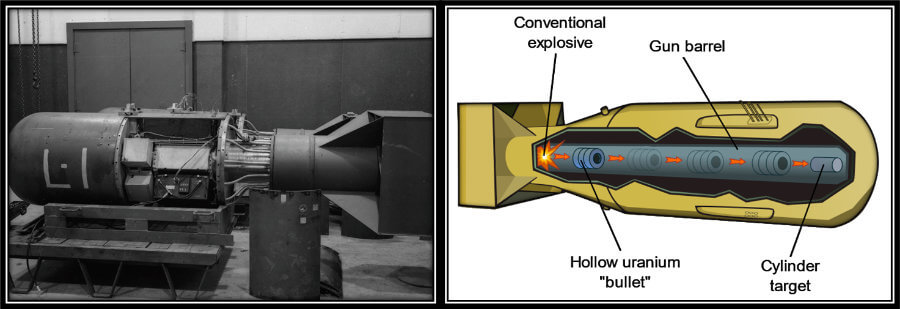
Little Boy (see figure above) consisted of a gun that fired a chunk of U-235 against another chunk of U-235, which resulted in a supercritical mass. Once the two masses of U-235 were joint, an initiator shot a series of neutrons, initiating the chain-reaction. The energy released was so immense that the bomb simply could not hold it in and blew itself apart.
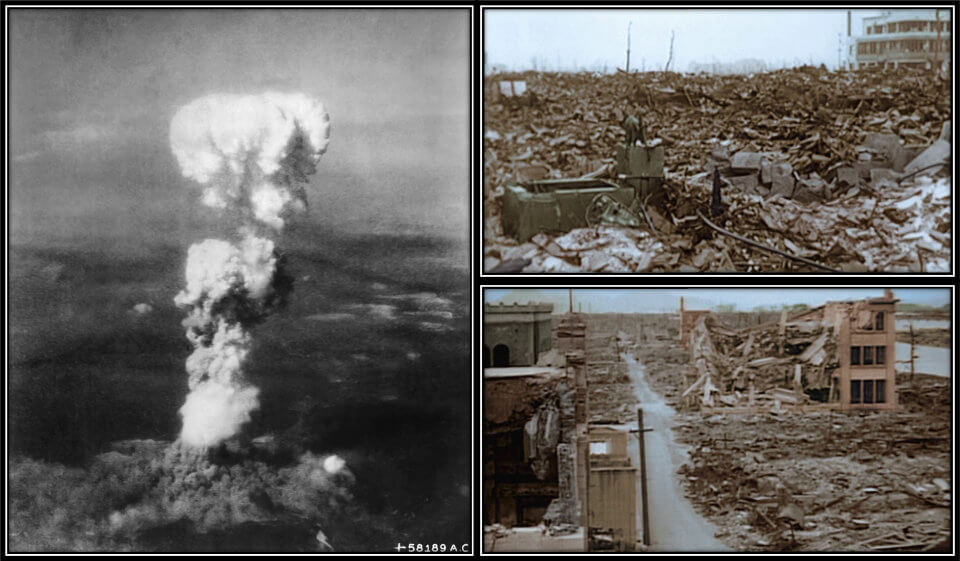
Little Boy was transported to the Mariana Islands. There, in the morning of August 6th, Colonel Paul Tibbots flew his B-29 plane, Enola Gay, en route to Hiroshima carrying Little Boy.
At 8.15 a.m. Little Boy was released.
The amount of destruction caused is simply mind-blowing. Just for comparison, the blast of a single ton of TNT is sufficient to turn an entire building into rubble; anyone standing within a 20-meter radius of the center of the explosion will be killed immediately.
Little Boy was 15.000 times more powerful!
That was no typo! Little Boy had the power of 15.000 tons of TNT!
About 50% of the energy from the Little Boy came in the form of blast energy, 35% from thermal energy and the remaining 15% from nuclear radiation.
Blast effects were what caused much of the destruction in Hiroshima. The shock waves from the blast produced sudden and extreme changes in air pressure and very high winds. These waves travelled faster than the speed of sound, decimating anything within an 1.6-km (1-mile) radius. Anyone standing in their way would have their internal organs bursting instantly.
Beyond that distance damage was caused by collisions with flying bits of buildings and other debris.

Thermal energy is the type of energy emitted in the form of light and heat.
Even though the bomb detonated 600 m above ground level, the ground temperature just under the mushroom cloud (the hypocenter) was incredibly high, about 5000 degrees Celsius or 9032 degrees Fahrenheit, which is way more than the melting point of iron! Thousands of people were instantly vapourised.
Because thermal radiation travels at about the speed of light, people would have seen a very bright light even before they had the chance to hear any explosion. Anyone looking in the direction of the explosion would be susceptible to flash-blindness.
People also experienced skin burns by the extreme heat, the severity of which depended on how close they were to the hypocenter.
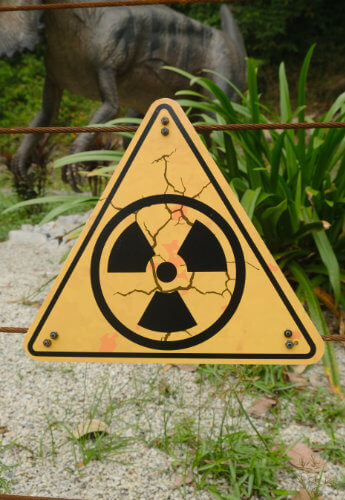
Nuclear radiation is the invisible, but just as deadly, form of energy from a nuclear explosion.
Most people in the critical blast area would have received lethal dosages of radiation. However, residual radiation would have also existed from the radioactive fallout, such as that produced from the fission products. Although some of these products only remain radioactive for a few seconds, others can be a hazard for many years.
In fact, in the weeks that followed the bombing, thousands of people died from radiation poisoning (e.g., from strontium-90). Sources regarding the death toll vary, but about 40.000 to 100.000 thousand people are estimated to have lost their lives.
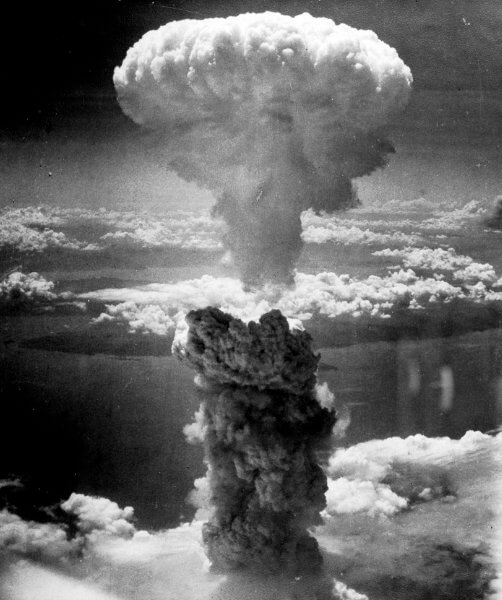
Staggeringly, the Hiroshima bombing did not force Japan to surrender.
On August the 9th, only three days after Hiroshima, the second bomb, Fatman, was dropped on the military port of Nagasaki. If you thought Little Boy was powerful, Fatman was even more, the equivalent of 20 tones of TNT. About 35.000-50.000 people died from the explosion, not killing more and doing more damage only because it exploded way off target – somewhere over the Urakami valley, instead of over the city itself.
At about the same time of the Nagasaki bombing, the Soviet Union declared war on Japan and invaded Japanese-occupied Manchuria and northern China.
Japan’s position in the war had become untenable, so, on the 2nd of September 1945, Japan surrendered unconditionally.
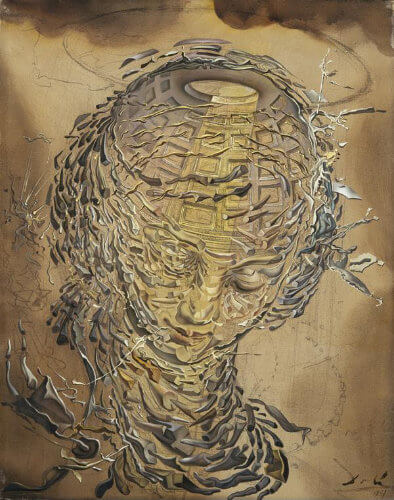
One of the things I admired about Dalí as an artist was his deep interest in the sciences. Copious letters survive as evidence of how Dalí kept close correspondence with mathematicians, physicists, biologists and neurologists.
His fascination with science led him to the works of Albert Einstein, Stephen Hawking and many others. He was so fascinated with science that even subscribed to scientific journals in order to keep up with the most recent scientific advances.
One particular field that was to become Dalí’s obsession was that of nuclear physics. After Germany invaded France during the beginning of the second World War, Dalí moved to the USA with his family.
The atomic bombing of Hiroshima and Nagasaki in August 1945 made an indelible mark on Dalí. Speaking to his friend André Parinaud, Dalí said:
“The atomic explosion of 6 August 1945 seismically struck me. Since that time, the atom has become my favourite subject of reflection. Many of the landscapes painted over this period express the great fear I felt at the news of that explosion. I was applying my paranoiac-critical method to the exploration of that world. I want to see and understand the power and hidden laws of things so as to gain control over them. In order to penetrate into the marrow of reality I have the genial intuition of having an extraordinary weapon available to me – mysticism, the deep intuition of what is, an immediate communion with the whole, absolute vision through the grace of truth, by divine grace”.
Salvador Dalí
With further developments in nuclear fusion, Dalí developed a unique style that he termed “nuclear mysticism”, which combined elements of diverse fields such as classical physics, Catholic mysticism and classicism. It was during this period that the Raphaelesque Head Exploding was produced.
And I believe the painting is a perfect illustration of that combination.
Let’s see what I mean by that.
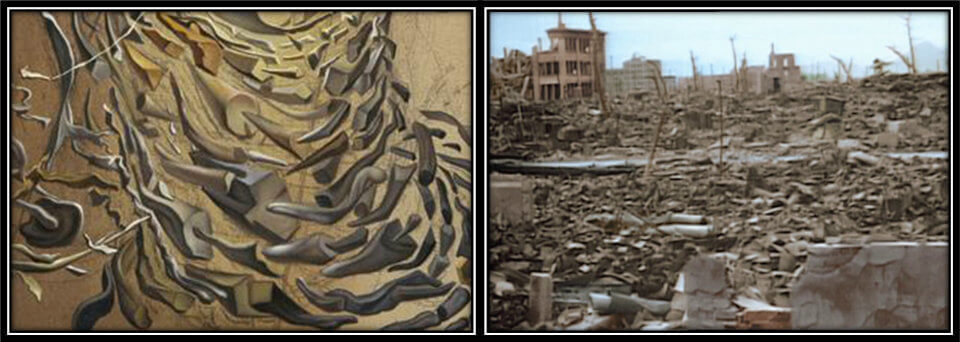
If you have read the section on The making of a bomb you will have an idea of just how destructive the atomic bombs dropped on Hiroshima and Nagasaki were.
The fragments on the painting could represent the disintegration of everything that happens to be in the path of such an atomic explosion.
Alternatively, they have also been interpreted as swirling sub-atomic particles, which, as explained above, are the constituents of the atoms that make up all matter.
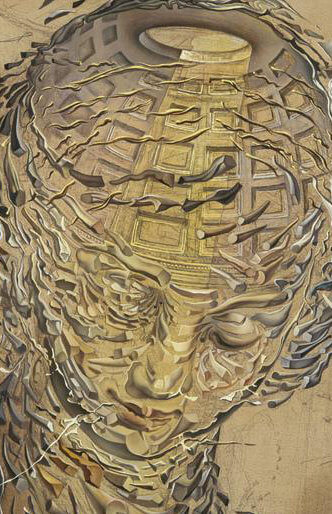
Another interesting connection to the effects of nuclear physics is the focus of light emanating from a hole at the top of the head (see figure above).
In physics, fission leads to the release of heat, which is converted into light. Indeed, many survivors of the Hiroshima bombing reported having seen a very bright light before any explosion sounds were heard. People looking in the direction of the explosion would experience flash-blindness.
Thus, it is not a stretch to think that the light shining through the head of the subject in Dali’s painting may be a representation of the blinding light that was emitted after the atomic explosion.

Both the clouds and halo are likely representations of the mushroom cloud seen after the nuclear explosions of the Hiroshima and Nagasaki bombing (see figure above).
In fact, note how the light seems to originate from this “mushroom cloud” above the head.
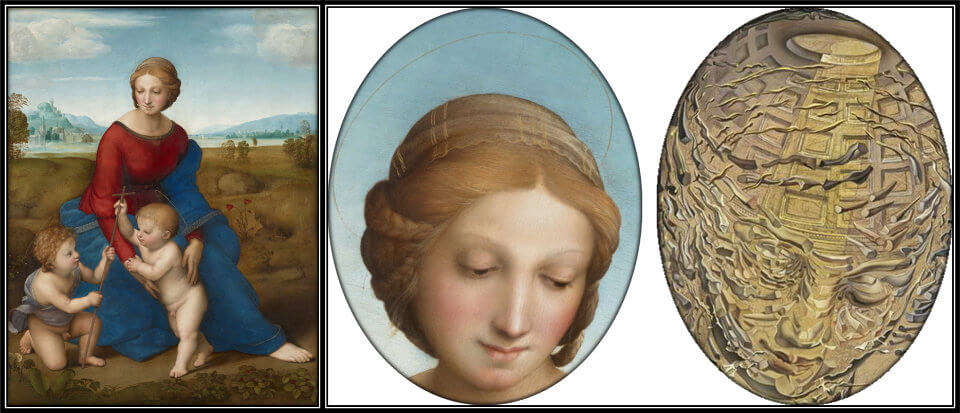
The identity of the face that appears in the painting is undoubtedly the face of Madonna, the Virgin.
In fact, this head is supposed to be a Raphaesque’s head (meaning a head based on the work of Raphael). The similarities between the head in Dalí’s painting and some of Raphael’s work depicting the Madonna are indeed staggering (see figure above).
It is a peculiar combination, classical physics and Christian iconography, but that was Dalí my friends.
Dalí is cleverly using the image of a Madonna – a prominent Christian symbol for purity – as a sharp contrast to the callous and wicked use of nuclear weapons.
And the effect is truly powerful.
Here you have an image of heavenly perfection being desecrated by human violence, aggressiveness and immorality. Making up the face with fragments akin to those resulting from a nuclear explosion confronts the viewer with two completely opposing ideas, leading to a certain confusion: we cannot really call the face beautiful, but we cannot call it ugly either.

Another interesting detail is that if you pay close attention to the area around the eyes you might just make out tears running down the face (I have highlighted some of them in a yellowish tone in the the figure above).
So, once again, Dalí is playing with contrasts. What you might believe to be a serene and content facial expression, now has the appearance of showing desperation and sorrow.

Above the head we see what appears to be a halo, further implicating Christian symbolism in this painting. A halo is often depicted in Christian art as a circle formed by rays of light. A Catholic interpretation of the halo could be that it represents perfection and divinity.
Again, Dalí is playing with contrasts here. The halo, symbol of perfection and divinity, stands in stark contrast to the horrible destruction caused by nuclear weapons, which, in Dalí’s painting, is represented by the condensation ring (very briefly, the shockwave caused by the explosion has an area of high and low pressure. In areas of low pressure, there is a drop in air temperature below its dew point. The moisture in the air condenses and forms water droplets, which is what makes up the “ring” we see in the photographs of nuclear explosions; see figure above).

Dalí also added a peculiar wheelbarrow at the bottom left corner of the painting, which blends itself naturally to the remaining fragments of the head.
Dalí purportedly painted the wheelbarrow after becoming enamoured with a painting called “The Angelus” by French Realist artist Jean Francois Millet (see figure above).
What is interesting about this fact is that Millet’s painting shows two peasants saying a Catholic prayer called “The Angelus”, signaling the end of a day’s work.
However, for some reason, Dalí became convinced that the scene did not depict a prayer ritual, but rather the mourning of a lost child. Astonishingly, the Louvre did detect an outline of a child’s coffin just under the basket of potatoes when it later X-rayed the painting!
Millet died several years before Dalí’s birth, so how Dalí came to this insight, no one really knows.
But we could speculate that the addition of the wheelbarrow in Dalís work is not only a tribute to Millet’s influence, but also a representation of a more poignant reality: the mourning of the dead from the atomic bombings.

The influence of classicism is also seen in Raphaesque Head Exploding with the depiction of the interior of the The Pantheon of Rome.
The Pantheon of Rome was originally built by Roman general and architect Agrippa sometime between 25-27 BC, in commemoration of the Battle of Actium, the infamous naval battle that saw the defeat of Mark Antony and Cleopatra. Patheon derives from the Greek word πάνθειος (pántheios), which means “of all gods”, so it is likely that the original Pantheon was a temple dedicated to the twelve Roman Gods.
After Agrippa’s Pantheon burned down in a fire in AD 80, Emperor Hadrian built his own version of the Pantheon on the same site around between 113-125 AD, which is the current building that survives to this day.
In the middle ages, the Pantheon was converted to a Christian church and renamed Sancta Maria ad Martyres (St. Mary and the Martyrs).

The Pantheon’s dome contains five rings of 28 rectangular coffers (square-shaped sunken panels) on its ceiling. The interior of the head is covered with coffered panels, just as the interior of the Pantheon (see figure above).
An oculus, the large uncovered opening on the ceiling of the Pantheon, provides the main source of natural light, and, in sunny days, you can see light beams entering the opening, illuminating the interior of the building. Likewise, the beam of light entering the opening at the top of the head simulates the effect of the light beam entering the oculus of the Pantheon.
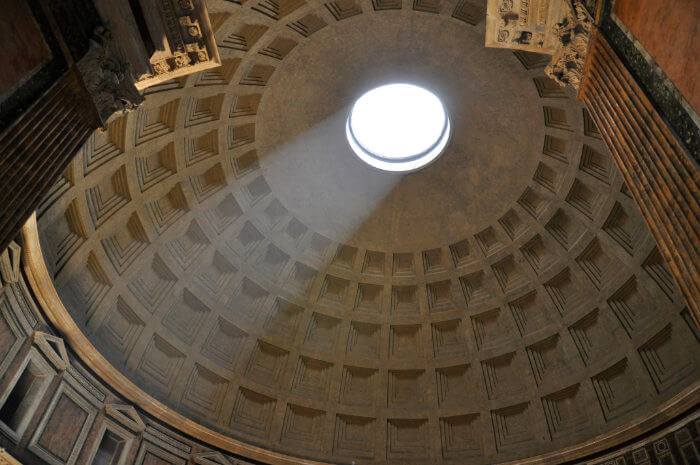
The Pantheon served as a great inspiration to Raphael, who requested to be buried there. Given Dalí’s fondness for Raphael’s works, I find these associations particularly relevant when analysing Dalí’s work.
Indeed, we can find at least three associations between Raphael and Dalí’s painting: the title, the Madonna, and the Pantheon. Perhaps, in a way, Raphaelesque Head Exploding was Dalí’s dedication to Raphael.
The Pantheon’s dome may have been built to resemble the heavens. The oculus was designed to function as a sundial, but also likely intended to represent the connection between mortal beings and the gods (the Pantheon was originally a pagan temple).
This suggests that the dome and the oculus in the painting are meant to represent something transcendental, godly or divine. What is Dalí trying to tell us by making this connection?
As Dalí became fascinated with nuclear physics, he took a special affinity with the idea of the atom making up everything in nature, which led him to attempt at unifying science and religion under the self-conceived notion of “Nuclear Mysticism”. Perhaps Dalí is mischievously insinuating that nuclear physics experimentation is, in a way, like playing God. In other words, he may have viewed the immense destructive power of nuclear weapons and the cataclysm it causes in a way that would rival the powers of the gods.
I should conclude with the note that even though Dalí was utterly shocked by the bombings on Hiroshima and Nagasaki, he also saw scientific progress (including the advances in nuclear physics) as an inevitable reality that the world of art needed to accommodate if it were to adapt the modern world.
One can only imagine the kind moral turmoil going inside Dalí’s head, hoping for unending scientific progress but terrified of its consequences.
Raphaelesque Head Exploding must be one of Dalí’s most enigmatic works.
The association to Raphael’s Madonna is very obvious but there is undoubtedly an inexplicable feeling of unease when viewing Dalí’s painting that we certainly don’t find in Renaissance works.
The central head is both beautiful and hideous, both pleasant and unpleasant, both safe and dangerous… Dalí achieved this effect by forcing viewers to contrast images of perfection and magnificence (Madonna’s gentle expression, the halo, the Pantheon) against images of defilement and desecration associated with destruction, war and pain (e.g., fragments composing the face, tears, the mushroom cloud, the condensation ring).
He also suffused the painting with symbolism. The bright light that illuminates the face has its origins in the halo and clouds above the head. Perhaps a representation of the blinding light resulting from a nuclear explosion? A wheelbarrow meshes with the head fragments. Perhaps a representation of mourning the deceased? The coffered panels of the Pantheon dome covering the interior of the head. Perhaps a representation of the almost god-like powers of manipulating the very fundamental structures of matter?
A Dalí painting, that’s for sure!
In retrospective, perhaps Huettel and colleagues chose Dalí’s painting for their fMRI book simply because, visually, it sort of appears that the light is illuminating the inside of the head which, figuratively speaking, is what fMRI is used for (i.e., it allows researchers to “visualise” the inner workings of the brain).
Whatever the reason, it was enough to grab my attention, and I can now rejoice that I have finally analysed one of my favourite paintings.
I can only thank the authors for that! 😊
See you in the next article!
Leave a comment
Add Your Recommendations
Popular Tags